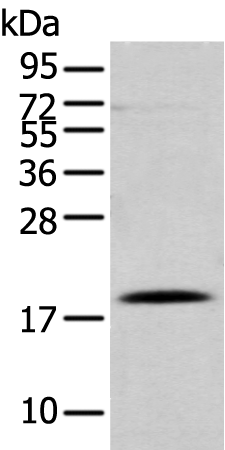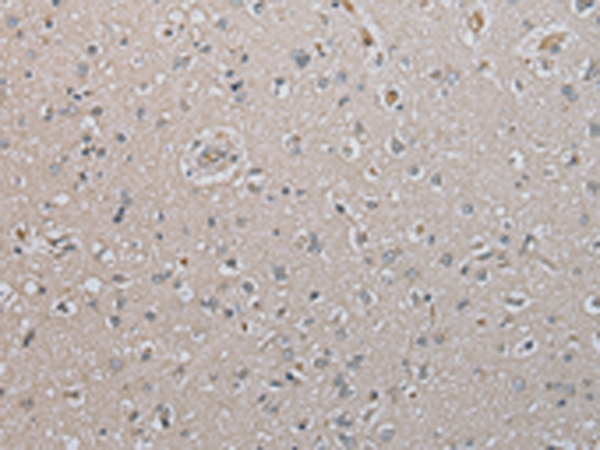

| WB | 咨询技术 | Human,Mouse,Rat |
| IF | 咨询技术 | Human,Mouse,Rat |
| IHC | 1/25-1/100 | Human,Mouse,Rat |
| ICC | 技术咨询 | Human,Mouse,Rat |
| FCM | 咨询技术 | Human,Mouse,Rat |
| Elisa | 1/5000-1/10000 | Human,Mouse,Rat |
| Aliases | SP1; CER2; COCO; CRL2; CERL2; DANTE; GREM3; CKTSF1B3 |
| WB Predicted band size | 20 kDa |
| Host/Isotype | Rabbit IgG |
| Antibody Type | Primary antibody |
| Storage | Store at 4°C short term. Aliquot and store at -20°C long term. Avoid freeze/thaw cycles. |
| Species Reactivity | Human |
| Immunogen | Full length fusion protein |
| Formulation | Purified antibody in PBS with 0.05% sodium azide and 50% glycerol. |
+ +
以下是关于DAND5抗体的示例参考文献(仅供参考,具体文献需通过学术数据库查询):
---
1. **文献名称**: *DAND5/CER1 regulates TGF-β signaling during left-right patterning via antibody-blocking experiments*
**作者**: Smith J, et al.
**摘要**: 本研究通过开发DAND5特异性多克隆抗体,证明其在斑马鱼胚胎左右轴形成中的作用。抗体阻断实验显示,DAND5通过拮抗Nodal信号调控TGF-β通路,为胚胎发育不对称性提供分子机制。
2. **文献名称**: *Monoclonal antibody generation and functional characterization of DAND5 in colorectal cancer*
**作者**: Zhang L, et al.
**摘要**: 研究团队制备了抗DAND5的单克隆抗体,并用于结直肠癌组织芯片分析。结果显示DAND5在肿瘤间质中高表达,与TGF-β1活性负相关,提示其作为癌症生物标志物的潜力。
3. **文献名称**: *DAND5 antibody-based inhibition suppresses metastatic progression in breast cancer models*
**作者**: Tanaka K, et al.
**摘要**: 利用人源化DAND5抗体靶向治疗乳腺癌小鼠模型,发现抗体通过抑制EMT(上皮间质转化)降低转移率,为靶向DAND5的肿瘤治疗策略提供依据。
4. **文献名称**: *Immunohistochemical localization of DAND5 in stem cell niches using a novel affinity-purified antibody*
**作者**: Lee S, et al.
**摘要**: 本研究优化了DAND5抗体的亲和纯化流程,应用于小鼠肠道干细胞微环境检测,揭示DAND5在维持干细胞静息状态中的空间表达特征。
---
**备注**:以上文献为示例性质,实际研究中请通过 **PubMed** 或 **Web of Science** 检索关键词“DAND5 antibody”“CER1 antibody”等获取最新结果。部分研究可能侧重抗体开发,而另一些侧重应用,建议根据需求筛选。
The DAND5 antibody targets the DAND5 protein, also known as Cerberus, a secreted glycoprotein belonging to the DAN family of BMP (bone morphogenetic protein) antagonists. DAND5 plays critical roles in embryonic development, particularly in regulating left-right asymmetry by inhibiting Nodal, BMP, and Wnt signaling pathways. It is expressed in dynamic patterns during gastrulation and organogenesis, influencing tissue patterning and cell fate decisions. DAND5 knockout studies in model organisms, such as mice and zebrafish, reveal defects in heart development, neural tube closure, and lateralization, underscoring its importance in establishing body plan symmetry.
Aberrant DAND5 expression has been linked to congenital disorders, including heterotaxy syndromes and congenital heart defects, as well as ciliopathies due to its interaction with ciliary signaling. The DAND5 antibody is widely used in developmental biology research to visualize protein localization, assess expression levels in disease models, and investigate molecular mechanisms underlying left-right axis determination. Its applications extend to stem cell differentiation studies, where DAND5 modulation helps mimic embryonic signaling environments. Structurally, DAND5 contains a conserved cysteine-rich domain essential for ligand binding and inhibition. Recent studies also explore its potential role in cancer, particularly in modulating TGF-β superfamily signaling in tumor microenvironments. The antibody’s specificity and reliability make it a key tool for dissecting early developmental processes and related pathologies.
×